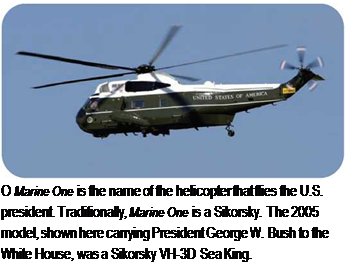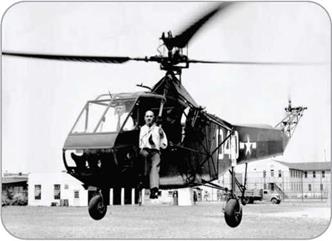Success in the United States
Sikorsky struggled during his first few years in the United States. In 1923, with the assistance of several other Russian exiles, he formed Sikorsky Aero Engineering Company to build airplanes.
|
О Sikorsky (seen here in the cockpit of a U. S. Coast Guard HNS-1 Hoverfly) saw the helicopter as a useful machine. As early as 1944, when this photo was taken, Sikorsky helicopters were used for rescue missions. |
Within a few years, Sikorsky was building successful aircraft again. His S-29 carried fourteen passengers. With two engines, it could reach a speed of 115 miles per hour (185 kilometers per hour). Sikorsky gave it an all-metal body.
Sikorsky’s company also produced the S-38, a ten-seater that could land on water. Pan American Airways bought several of these planes as the airline began to build its network, providing an air service to South America. Sikorsky based his company at Stratford, Connecticut. He became an U. S. citizen when he was naturalized in 1928.
Sikorsky ran into problems in 1929. He had built and sold several expensive planes, called “flying yachts,” to wealthy businessmen. The planes were not all paid for when, in October 1929, the stock market in New York City crashed.
 Most of Sikorsky’s customers lost their fortunes when the stocks they owned plunged in value. As a result, many of the buyers did not make their promised payments. Losing money, Sikorsky sold out to the United Aircraft Corporation. Sikorsky continued to produce planes for Sikorsky Aircraft, which has remained part of what is now United Technologies Corporation (UTC).
Most of Sikorsky’s customers lost their fortunes when the stocks they owned plunged in value. As a result, many of the buyers did not make their promised payments. Losing money, Sikorsky sold out to the United Aircraft Corporation. Sikorsky continued to produce planes for Sikorsky Aircraft, which has remained part of what is now United Technologies Corporation (UTC).
Sikorsky’s next achievement was one of his most impressive. In 1931, the company launched the S-40, or the American Clipper. This large flying boat carried four engines. Pan American bought the planes and, by the late 1930s, was using Clippers to provide air service across both the Pacific and Atlantic oceans.











